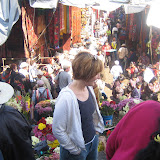One such was two weekends ago to the town of Chichicastenango (or Chichi to us gringos). Chichi is first and foremost known for its biweekly market which is said to be the most colorful in Guatemala, Central Amercia and possibly all of the Americas. The town has been a dominant trading hub in the largely Mayan area for centuries and it was overwhelmingly impressive. Market days are Thursday and Sunday and they are packed -- so much so that many friends recommended you go the night before in order to be up for the early morning (4am!) sales by candlelight.
A bit of backround again from Wikipedia (very similar and much easier that typing from our guidebook)...
The market and experience was wonderful and it really is as colorful and erratic as it sounds. Pictures are below, but a bit about the trip overall...The famous handicraft market of Chichicastenango draws not only the K'iche' Maya of the surrounding region, but vendors from all over Guatemala. They represent many of Guatemala's linguistic groups: Mam, Ixil, Kaqchikel, and others (Guatemala has 23 indigenous languages). Each person hawks his or her products in a cacophony of color, dialects, costumes, smoke, and smells.
Vendors start setting up their own portable booths in the main plaza and nearby streets of Chichicastenango the night before and set-up continues into the early daylight hours. Although it is sometimes not immediately apparent, the market is very well organized. Vendors of specific types of items occupy traditional places in the market. The fruit and vegetable vendors have their traditional area that they occupy, as well as the vendors of pottery, wooden boxes, condiments, medicinal plants, candles, pom and copal (traditional incense), cal (lime for preparing tortillas), grindstones, pigs and chickens, machetes, and other tools. In the central part of the market plaza are comedores (small eateries, which tourists are advised not to eat at).
Among the items sold are textiles, particularly the women's blouses. The manufacture of masks, used by dancers in traditional dances has also made this city famous for woodcarving. Much of what is sold is of good quality, but there are also products in Chichicastenango's many factories for the not-so-discerning foreign
companies.Early in the day, homemade rockets and firecrackers are set off and continue randomly throughout the day. The smell of incense burned at the church of Santo Tomás (on the steps and in the nave) and fireworks mingle together.
Our school organized the outing and there were maybe 25 other people with us. The travel in the two private microbuses (squatty minivan type vehicles you don't see in the states) was a "trip" in itself and makes us really look forward to riding chicken buses all over Central America! We were winding through the mountains on a two lane road, mostly well paved, and passing other cars/trucks/bikes at will. And the passing system here is a bit different than what we might be used to, or shall I say one that we are "comfortable" with. Think of those pretty double yellow lines in two lane highways that are conveniently dotted when someone decided it is safe to pass -- or solid yellow lines advising against it....they may even have some legality attached to them in the states.
Okay, now forget about pretty yellow lines, add lots of turns on mountain roads, little use of the brakes at any point, lots of honking, and one of the teachers pops in a CD and on the radio starts blasting none other than -- Highway to Hell!! I promise I'm not making this up. I actually got out my camera to take short video to document the insane irony. Fortunately, the 80s jam continued for an entire CD which we jammed to for a good portion of the 4 hour trip. How fitting a start!
We arrived safely in Chichi and had about 4 hours to wander, look, smell, and, of course, bargain. It seems to be the way things go. The vendors really are talking/yelling at anyone who passes, but particularly to foreigners. As expected, the experience came with mixed emotions. It is partly invigorating (and fun!) to really bargain and feel very much a part of the centuries old market system, but it is simultaneously disheartening as they lowered their prices again and again.
Still very ignorant of the economy, it is hard to know just what was behind it all. When she lowered the price of a table runner from 700Q to 400Q without our saying anything at all but only by starting to walk away, does it show the level of inflation that comes with our skin or just how much they need the money? Did the few dollars we paid for shirts and a bag cover the production costs? What exactly are "production costs" here anyway? Outside of material costs, how is an individual's labor value determined? Does it depend more on how much money they need at the time of the sale than the countless hours that went into the beautifully hand woven crafts?
So much more to learn...
We were fortunate enough that in the next week, the school also organized a weaving demonstration and testimony from a local women's cooperative. It helped give insight into the artisan culture. More on that later. For now, enjoy the pictures of Chichicastenango...

No comments:
Post a Comment